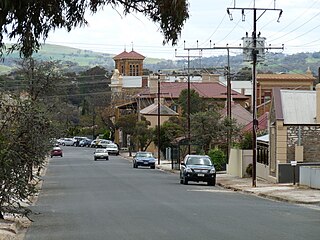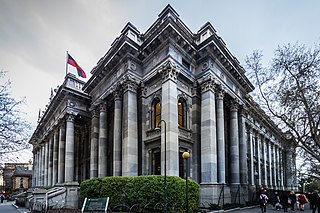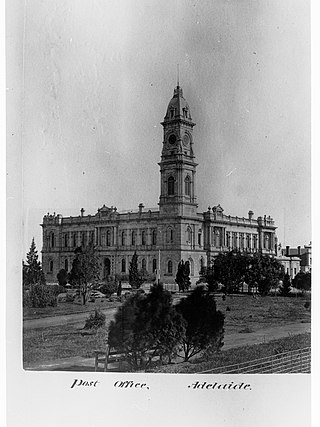Related Research Articles

Kapunda is a town on the Light River near the Barossa Valley in South Australia. It was established after a discovery in 1842 of significant copper deposits. The population was 2,917 at the 2016 Australian census.

The first railway in colonial South Australia was a line from the port of Goolwa on the River Murray to an ocean harbour at Port Elliot, which first operated in December 1853, before its completion in May 1854.

Parliament House, on the corner of North Terrace and King William Road in the Adelaide city centre, is the seat of the Parliament of South Australia. It was built to replace the adjacent and overcrowded Parliament House, now referred to as "Old Parliament House". Due to financial constraints, the current Parliament House was constructed in stages over 65 years from 1874 to 1939.

Edmund William Wright was a London-born architect in the colony of South Australia. He was mayor of Adelaide for 10 months in 1859. He built many civic, commercial, ecclesiastical, and residential buildings in Adelaide city centre and its suburbs, in styles influenced by French and Italian Renaissance, as well as Neoclassical architecture.
Adelaide Educational Institution was a privately run non-sectarian academy for boys in Adelaide founded in 1852 by John Lorenzo Young.
He avoided rote learning, punishment and religious instruction, but taught moral philosophy, physiology, political economy and mechanical drawing ... (and) surveying on field trips.

Charles Hervey Bagot, often referred to as "Captain Bagot", was a South Australian pastoralist, mine owner and parliamentarian, and was the ancestor of a number of notable South Australian citizens.
William Hanson MICE was a government engineer in the early days of the colony of South Australia.

The Bunyip is a weekly newspaper, first printed on 5 September 1863, and originally published and printed in Gawler, South Australia. Its distribution area includes the Gawler, Barossa, Light, Playford, and Adelaide Plains areas. Along with The Murray Pioneer, The River News, and The Loxton News,The Bunyip was now owned by the Taylor Group of Newspapers and printed in Renmark.

Edward John Woods F.R.I.B.A. was a prominent architect in the early days of South Australia.
George Ernest Hamilton CE was a British civil engineer who played a leading role in development of the Colony of South Australia.

Henry Richard Mildred was a politician in the early days of the Colony of South Australia.

The Morgan railway line or North-West Bend railway was a railway line on the South Australian Railways network.

General Post Office, a colonial-era building situated on 141 King William Street on the north-west corner of King William Street and Victoria Square, is the former General Post Office for South Australia, Australia, Postal services operated from the building between 6 May 1872 and 11 October 2019.

Edward Lindley Grundy was a businessman, politician and editor in the young colony of South Australia.
Henry Hay Mildred was a lawyer and politician in the colony and State of South Australia.
James "Nobby" White was a pastoralist, land agent and politician in the colony of South Australia.

Pilgrim Uniting Church is a Uniting church located on Flinders Street, Adelaide in South Australia.
Henry Hussey was a pastor in the colonial days of South Australia, closely associated with the Christian Church on Bentham Street along with pastors Abbott, Finlayson and Playford. He was the author of several influential books on religious themes, and a memoir.
Rev. James Young Simpson was a Wesleyan Methodist minister in South Australia, born in Scotland, a nephew and namesake of James Young Simpson, the celebrated pioneer of chloroform as an anaesthetic.
Joseph John Green founded a leather warehouse in Hindley Street, making boot uppers and supplying leather and grindery to the bootmaking trade. He was a prominent community leader and philanthropist.
References
- 1 2 "Mr Edward Hamilton". Former members of the Parliament of South Australia . Retrieved 19 August 2022.
- 1 2 3 4 5 "Hamilton, Edward Angus". Architects Database. University of South Australia.
- ↑ Mennell, Philip (1892). . The Dictionary of Australasian Biography. London: Hutchinson & Co – via Wikisource.
- 1 2 3 "Digging up the Past". The Register . Adelaide. 15 November 1924. p. 10. Retrieved 25 August 2014– via Trove.
- ↑ "Opening of the Wallaroo Railway". South Australian Weekly Chronicle . Adelaide. 14 July 1866. p. 7. Retrieved 14 August 2014– via Trove.
- 1 2 Sullivan, Christine (2008). "Architect Personal Details: Wright, Edmund William". Architects of South Australia. University of South Australia . Retrieved 14 April 2024.
- ↑ "The Kapunda Herald". Kapunda Herald and Northern Intelligencer . S.A. 21 April 1871. p. 2. Retrieved 15 August 2014– via Trove.
- ↑ "St. George's Church, Gawler". The Bunyip . South Australia. 1 May 1874. p. 4. Retrieved 12 December 2019– via Trove.